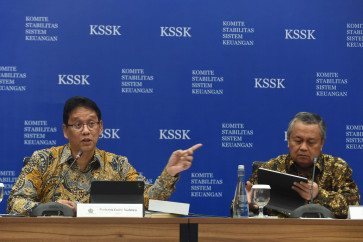Popular Reads
Top Results
Can't find what you're looking for?
View all search resultsPopular Reads
Top Results
Can't find what you're looking for?
View all search resultsSeaweed farmers in Nusa Lembongan pushed aside by tourism development
Seaweed farmers in Nusa Lembongan, Klungkung regency, have been negatively affected by the tourist boom on the small island located southeast of Bali
Change text size
Gift Premium Articles
to Anyone
S
eaweed farmers in Nusa Lembongan, Klungkung regency, have been negatively affected by the tourist boom on the small island located southeast of Bali.
They are facing a problem of regeneration, as young people on Nusa Lembongan mostly prefer to work in the tourism industry, which promises better earnings than working as a seaweed farmer.
“Young people don’t want to follow in the path of their parents. They choose to work in tourism,” Made Sutra of Jungutbatu village said while collecting seaweed to be dried under the sun.
The 46-year-old said some older farmers had abandoned areas where they used to cultivate the seaweed, indicating one such area currently used to park boats transiting between Nusa Lembongan and Sanur.
They abandoned the areas because they were no longer able to work as farmers due to their physical condition.
Sutra said he was saddened by the possibility that seaweed farming could vanish from the island someday, if there was no regeneration. “Some older farmers are no longer able to work as farmers. They are not as strong as they used to be.”
“Old people like me cannot work in the tourism industry because we don’t have the skills. I can’t even speak English. So I don’t have any other choice than being a farmer.”
Wayan Supratman, another farmer, agreed, saying that the island’s tourism boom had afflicted seaweed farmers.
The 30-year-old might be an exception, however, as he now works as seaweed farmer and as a tourist guide.
“Tourism is not always good every day. We experience a low season and a high season.”
He said seaweed farming experienced its heyday around 2000, while tourism development began starting in 2005.
“Farmers used to be able to harvest 40 tons per month, but now it has dropped to around 25 tons, with a low price of only Rp 7,000 (77 US cents) to Rp 8,000 per kilogram.”
With more villas and other tourist facilities being built there, farmers are beginning to lose space to dry the seaweed under the sun, he added.
Seaweed farming occurs on large tracts of Nusa Penida, Nusa Lembongan and Nusa Ceningan.
According to a 2009 survey by The Nature Conservancy (TNC), 310 hectares have been dedicated to seaweed farming across the three islands.
Farmers collect an average of 40 to 50 tons each harvest. The price of seaweed fluctuates significantly, with spinosum ranging between Rp 2,000 and Rp 2,900 per kilogram, and cottoni between Rp 4,000 to Rp 5,300 per kilogram.
Seaweed was usually planted every 35 days, farmers in Jungutbatu village said. The village accommodates around 600 families, who mostly work in the seaweed farming industry.
After the harvest, farmers dry the seaweed under the sun for two to three days, depending on the season. During the rainy season, drying can take a week. Dried seaweed is sold by the farmers to traders, who will then resell the commodity in Surabaya, East Java, and other big cities for processing before being exported. A farmer usually sells between 500 kilograms to 1 ton per month.










